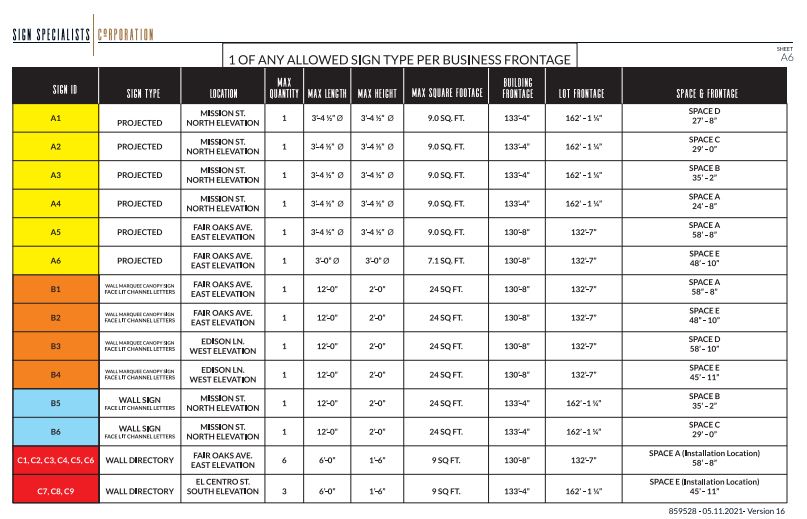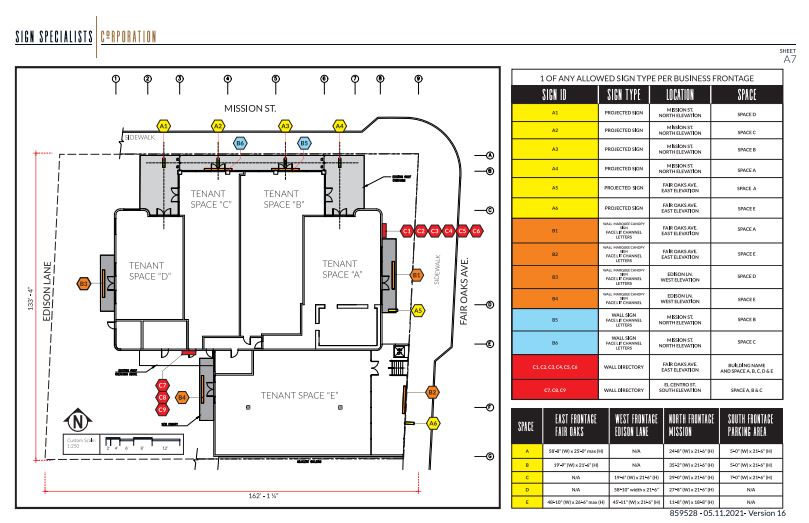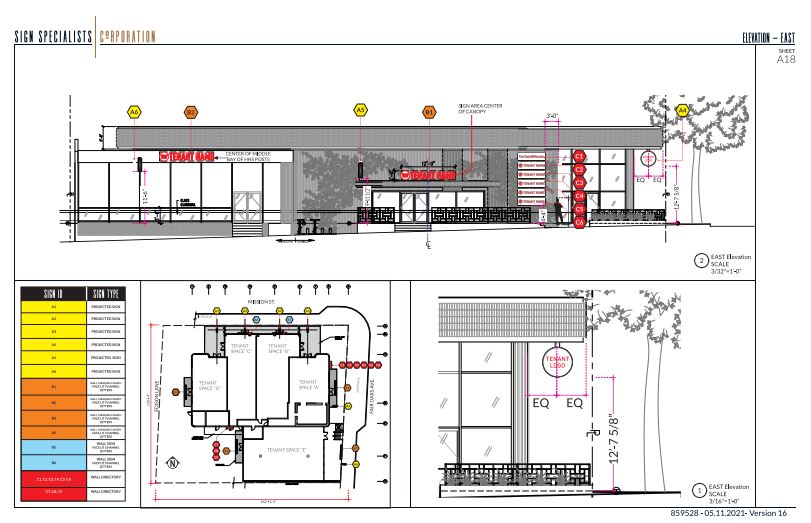Definition
A Master Sign Program is a comprehensive document that contains a set of sign criteria that is unique to a specific shopping center, commercial property, building or development that has the need at present or potentially in the future, for three or more tenant signs. Master Sign Programs go through a formal application and approval process with the local city or municipality and are kept on file and referred to by address when new sign designs are presented to the city for the purpose of permitting. Because the Master Sign Program has been previously vetted and approved by the city it sets the standard for what is allowed for the property/address specified. As a result, when a permit application package that conforms with the Master Sign Program is submitted to the city, it typically sails smoothly through the approval process.

Why and Under What Circumstances are they Required?
Master Sign Programs are required to ensure that adequate signage is provided to all prospective tenants within multi-tenant buildings or developments. The document provides a consistent visual theme for multi-tenant buildings or multiple business establishments located in a single development project. Such programs include standards for sign types, sizing, fonts, lighting, background and other elements of graphic design and placement. Newer or more modern buildings or developments will typically have an Approved Master Sign Program before any tenant even moves into their leased space.
Exceptions to the general sign regulations may include, but are not limited to, the number of signs, height, location, sign area, sign type, attachment method and illumination. Master Sign Programs are in substantial compliance with the general regulations, and each exception will further the general objectives of these regulations. A Master Sign Program may not be used to display sign types that are prohibited.
Master Sign Programs are applicable to multiple establishments within a single development only. Sign requirements that are contained within a sign program criteria differ from those in the City’s Development Code.

Benefits of a Master Sign Program
Building Ownership
- A clearly defined Master Sign Program takes the guess work out of what should be considered or accepted. Ideally the MSP will make leased space more marketable to tenants who desire prominent exposure for branding and promotional purposes. The Sign Program protects building ownership by setting an accepted standard for various exterior signage types throughout the entire property. The potential for what could be deemed “sign pollution” is eliminated. Documented specifics consider the building(s) exterior, the landscape and aim to maintain conformance and aesthetic consistency by allowing for signage that takes the bigger picture into consideration. New signage must be geared to complimenting the property and existing signage already in place.
Property Management
- The Sign Program simplifies the Property Manager’s responsibilities and approval process by clearly defining specifics including which tenants qualify for which signage types and what placement locations are available. It also makes it easy for them to identify a tenant who has breached the guidelines.
Tenant
- When branded promotional messaging is a critical component of your office or retail space selection criteria the Master Sign Program should be requested and taken into consideration. The Sign Program defines specifics making it easier for tenants to determine what is and isn’t permitted for their leased space. Signage rights are clearly defined so that major tenants (leasing an entire floor or more) are offered prime positioning for exterior promotional signage on building tops (parapet) or low levels (eyebrow) based on their status. In addition, the sign program protects individual tenants from other tenants who might otherwise infringe on their rights or encroach on their space.

Saving Time and Avoiding Disappointment
When building ownership changes hands or a new property management firm secures the contract to manage the property all too often, they can be unaware of an existing Master Sign Program. When this happens the guidance or direction, they provide to a new tenant can be naïve, vague and or completely misleading. In extreme circumstances, a tenant may be told that exterior building signage is allowed, and they can do whatever they want which can be either partially or completely false. If the property is newer (1995 or later) and it is a moderate to high end commercial or retail location, you are advised to err on the side of caution before making any signage selections or decisions. Take appropriate measure to ensure that you know for certain whether a Master Sign Program exists. Otherwise you risk investing precious time and financial resources into something that may not even be possible.

How to Acquire a Copy of the Master Sign Program
The Master Sign Program will typically be provided to tenants by the property manager as part of their lease documentation or as a separate document at the time that the lease is provided to them. If the Sign Program is dated and the property has changed hands the property manager may not be aware that one exists and/or they may not have a digital copy of the Sign Program available. Once the Sign Program has been approved by the local city government a copy of it will be on file by address with the planning department. It can often be obtained by phoning or emailing them and requesting a copy be sent by email.

When none exists in a commercial or retail space with three or more tenants the local city or municipality sign ordinance sets the guidelines or standards for what is allowed even though the property manager or landlord’s approval is still required prior to presenting a sign package to the city for the purpose of permitting. You are however encouraged to proceed with caution because it is becoming more common for municipalities to mandate the creation and implementation of an approved Master Sign Program before they will process permit applications for qualifying properties. Some cities have established “triggering events” in their municipal code, which is a criteria whereby the need for a Master Sign Program becomes automatic. When no Master Sign Program exists, it is possible that the allowable space for signage has already been met or exceeded by tenants already occupying the building.

If you own a building or buildings and require professional expertise to work through the Master Sign Program Application and Approval process with your local city government, it’s recommended that you connect with the talent and expertise necessary to spearhead your project and navigate it through to approval.

Amending an Existing Master Sign Program
A Master Sign Program that went through the formal approval process many years previously may no longer be relevant to the present day situation, tenant branding preferences, a specific need or advancements in the world of signage. The original Sign Program Submittal may have had a very narrow scope that is too limiting or specific for the present day. Depending on how extreme or extensive the request is, an amendment request may be a very simple application process that amounts to nothing more than a rubber stamp. However, in more extreme cases where the revisions being requested are considered extensive the process can be lengthy (up to two years depending on the city), costly, and it may result in the city declining all or parts of the amendments being requested. In any instance, when an amendment request is submitted, a prepaid city fee applies and it is typically the party applying for the amendment who is responsible for the expense.



